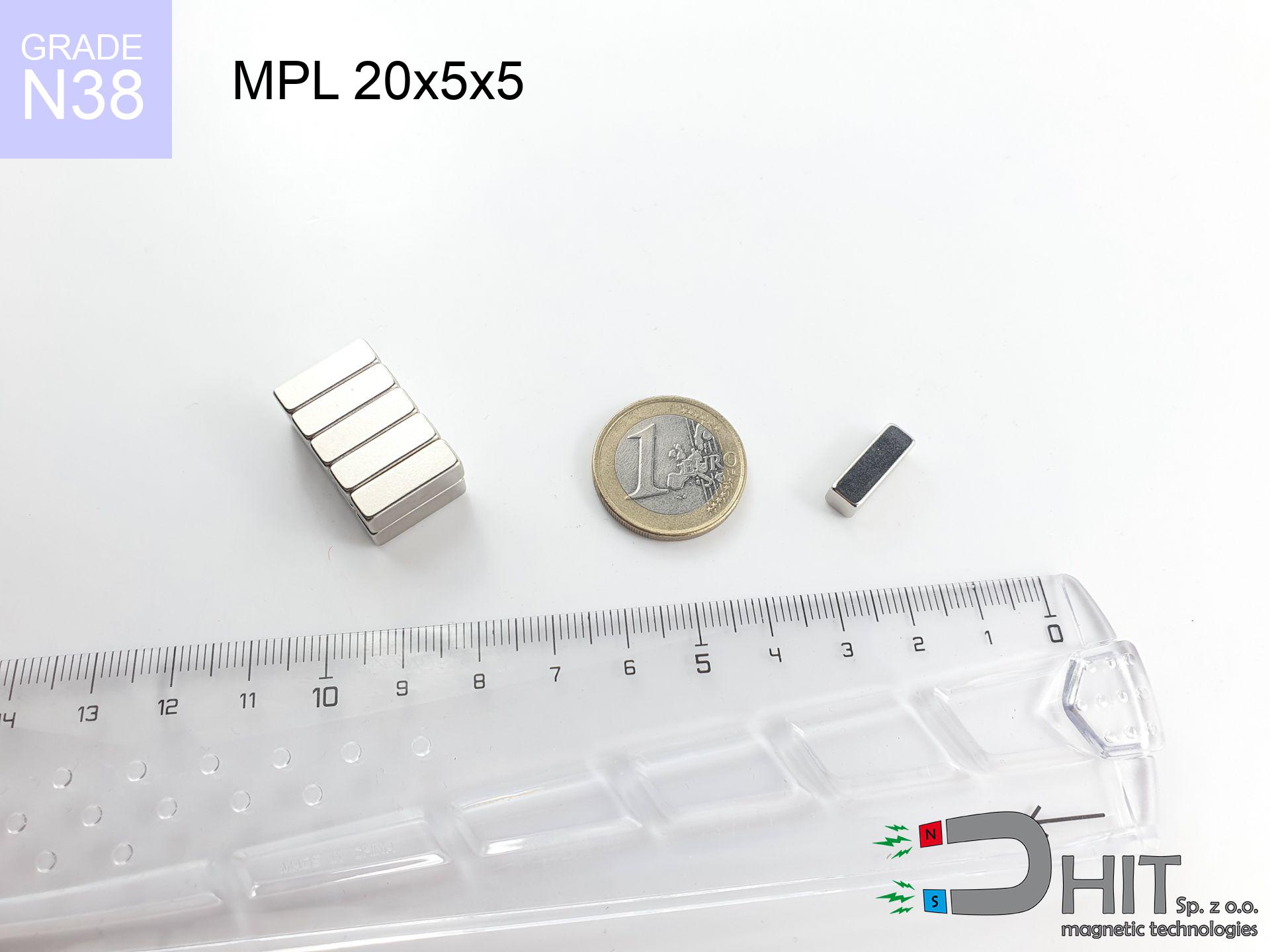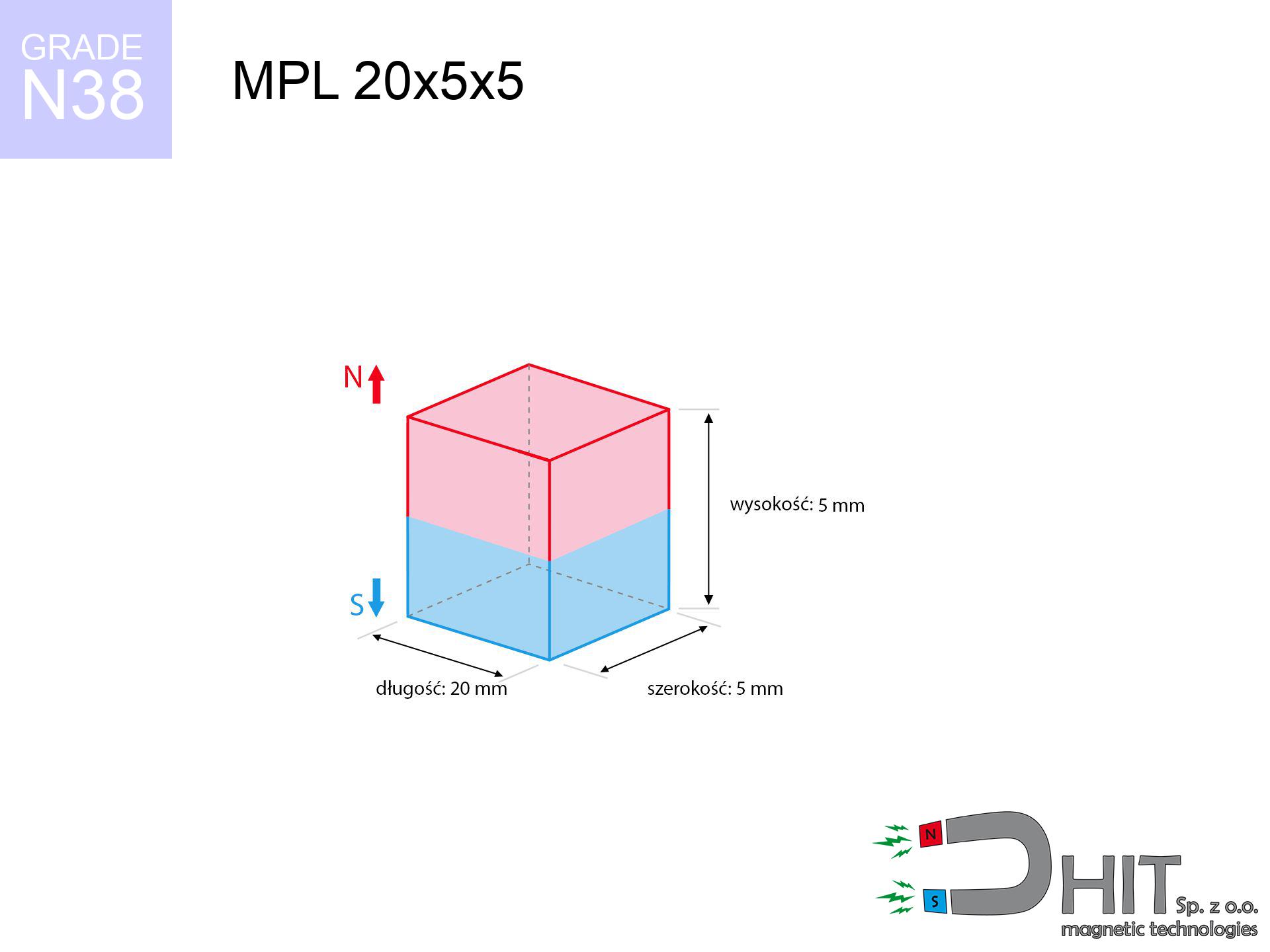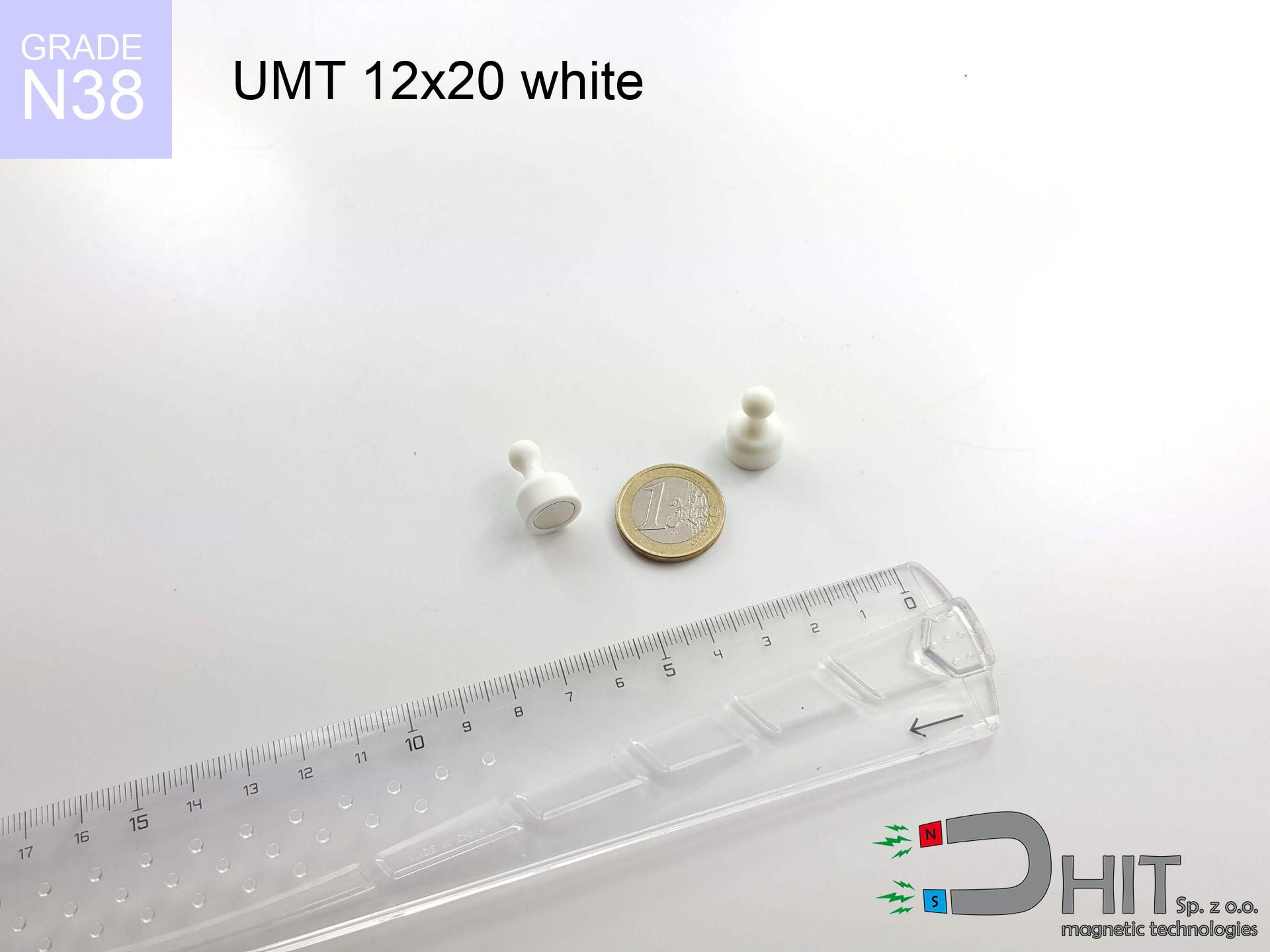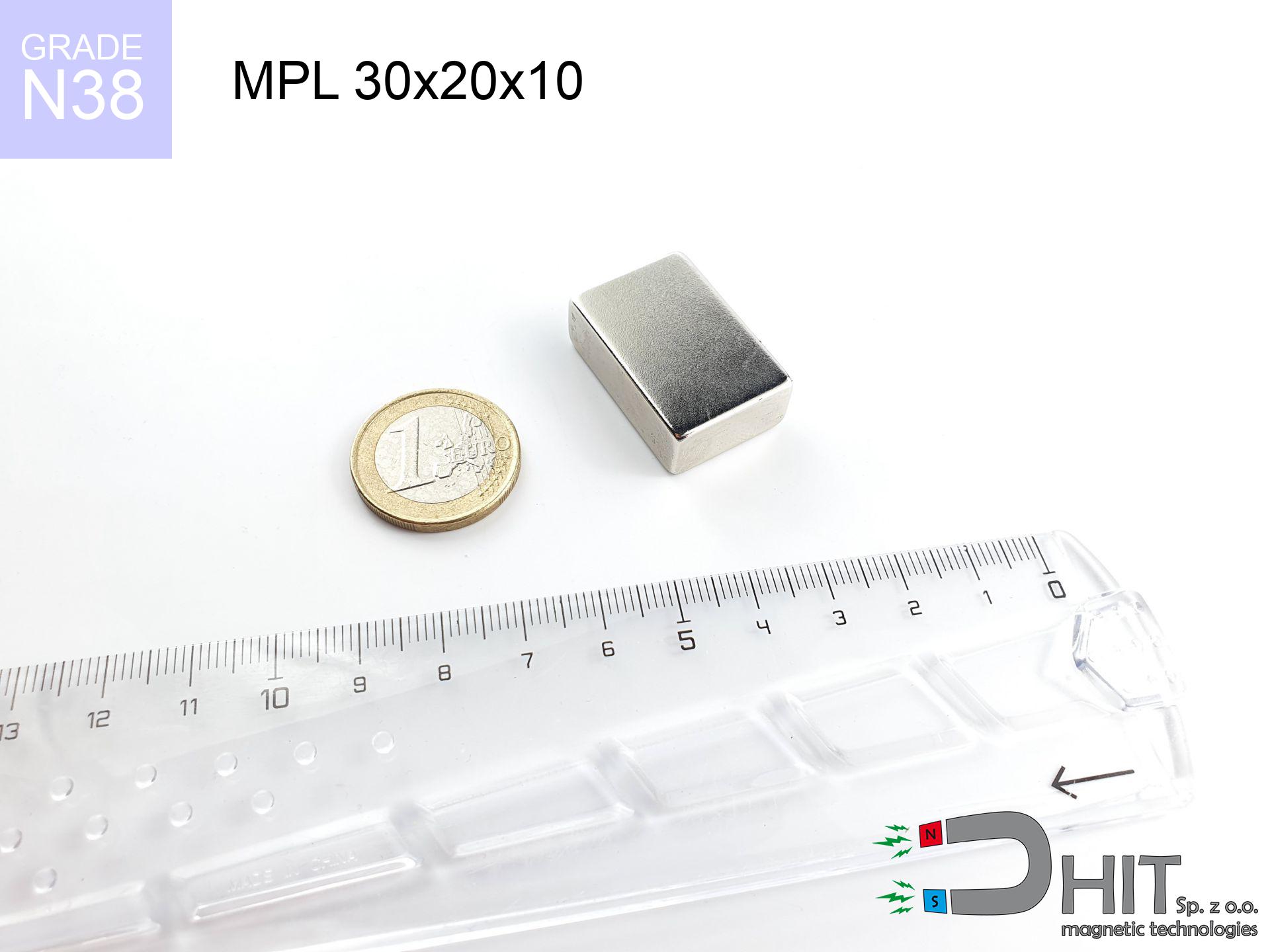MPL 20x5x5 / N38 - lamellar magnet
lamellar magnet
Catalog no 020132
GTIN: 5906301811381
length [±0,1 mm]
20 mm
Width [±0,1 mm]
5 mm
Height [±0,1 mm]
5 mm
Weight
3.75 g
Magnetization Direction
↑ axial
Load capacity
3.95 kg / 38.74 N
Magnetic Induction
456.78 mT
Coating
[NiCuNi] nickel
2.76 ZŁ with VAT / pcs + price for transport
2.24 ZŁ net + 23% VAT / pcs
bulk discounts:
Need more?Want to negotiate?
Give us a call
+48 888 99 98 98
alternatively let us know using
inquiry form
the contact form page.
Lifting power along with shape of neodymium magnets can be tested on our
power calculator.
Orders submitted before 14:00 will be dispatched today!
Magnetic properties of material N38
Physical properties of sintered neodymium magnets Nd2Fe14B at 20°C
Shopping tips
Pros and cons of NdFeB magnets.
In addition to their magnetic efficiency, neodymium magnets provide the following advantages:
- They virtually do not lose power, because even after ten years the performance loss is only ~1% (based on calculations),
- They maintain their magnetic properties even under external field action,
- By using a reflective layer of nickel, the element presents an proper look,
- The surface of neodymium magnets generates a intense magnetic field – this is one of their assets,
- Thanks to resistance to high temperature, they are capable of working (depending on the form) even at temperatures up to 230°C and higher...
- Due to the potential of flexible shaping and customization to specialized requirements, magnetic components can be produced in a wide range of forms and dimensions, which increases their versatility,
- Key role in advanced technology sectors – they are utilized in magnetic memories, drive modules, medical devices, as well as technologically advanced constructions.
- Relatively small size with high pulling force – neodymium magnets offer high power in tiny dimensions, which allows their use in small systems
Disadvantages of NdFeB magnets:
- To avoid cracks under impact, we suggest using special steel housings. Such a solution protects the magnet and simultaneously improves its durability.
- We warn that neodymium magnets can lose their strength at high temperatures. To prevent this, we suggest our specialized [AH] magnets, which work effectively even at 230°C.
- When exposed to humidity, magnets usually rust. To use them in conditions outside, it is recommended to use protective magnets, such as magnets in rubber or plastics, which secure oxidation as well as corrosion.
- Limited ability of creating threads in the magnet and complex shapes - preferred is cover - magnet mounting.
- Health risk to health – tiny shards of magnets are risky, when accidentally swallowed, which is particularly important in the context of child safety. It is also worth noting that small components of these magnets can disrupt the diagnostic process medical in case of swallowing.
- Higher cost of purchase is a significant factor to consider compared to ceramic magnets, especially in budget applications
Maximum lifting capacity of the magnet – what affects it?
The declared magnet strength concerns the maximum value, recorded under optimal environment, specifically:
- on a plate made of mild steel, optimally conducting the magnetic field
- possessing a massiveness of minimum 10 mm to avoid saturation
- with a plane perfectly flat
- without any clearance between the magnet and steel
- during detachment in a direction vertical to the mounting surface
- in neutral thermal conditions
Practical aspects of lifting capacity – factors
In practice, the actual holding force is determined by several key aspects, presented from most significant:
- Space between surfaces – even a fraction of a millimeter of separation (caused e.g. by varnish or dirt) drastically reduces the pulling force, often by half at just 0.5 mm.
- Force direction – catalog parameter refers to detachment vertically. When slipping, the magnet holds significantly lower power (typically approx. 20-30% of maximum force).
- Wall thickness – thin material does not allow full use of the magnet. Part of the magnetic field penetrates through instead of converting into lifting capacity.
- Steel grade – ideal substrate is high-permeability steel. Stainless steels may attract less.
- Surface finish – full contact is possible only on polished steel. Any scratches and bumps create air cushions, weakening the magnet.
- Thermal factor – hot environment weakens pulling force. Too high temperature can permanently damage the magnet.
* Lifting capacity testing was carried out on plates with a smooth surface of suitable thickness, under a perpendicular pulling force, however under shearing force the holding force is lower. Moreover, even a slight gap {between} the magnet’s surface and the plate decreases the load capacity.
Safe handling of NdFeB magnets
Do not underestimate power
Handle magnets with awareness. Their powerful strength can shock even experienced users. Be vigilant and respect their force.
Safe distance
Device Safety: Neodymium magnets can ruin data carriers and sensitive devices (pacemakers, medical aids, timepieces).
Magnetic interference
Remember: neodymium magnets produce a field that disrupts sensitive sensors. Maintain a safe distance from your mobile, device, and navigation systems.
Life threat
Health Alert: Neodymium magnets can deactivate heart devices and defibrillators. Stay away if you have medical devices.
Protective goggles
Protect your eyes. Magnets can fracture upon violent connection, ejecting sharp fragments into the air. Eye protection is mandatory.
Pinching danger
Large magnets can break fingers in a fraction of a second. Never put your hand betwixt two attracting surfaces.
Mechanical processing
Dust generated during machining of magnets is flammable. Do not drill into magnets without proper cooling and knowledge.
Operating temperature
Keep cool. Neodymium magnets are susceptible to heat. If you require operation above 80°C, ask us about HT versions (H, SH, UH).
This is not a toy
Always store magnets away from children. Choking hazard is high, and the effects of magnets clamping inside the body are fatal.
Sensitization to coating
Some people have a sensitization to Ni, which is the typical protective layer for NdFeB magnets. Prolonged contact can result in skin redness. We suggest wear protective gloves.
Attention!
Want to know more? Check our post: Are neodymium magnets dangerous?




![UMGZ 36x18x8 [M6] GZ / N38 - magnetic holder external thread UMGZ 36x18x8 [M6] GZ / N38 - magnetic holder external thread](https://cdn3.dhit.pl/graphics/products/um-36x18x8-m8-gz-xiv.jpg)




